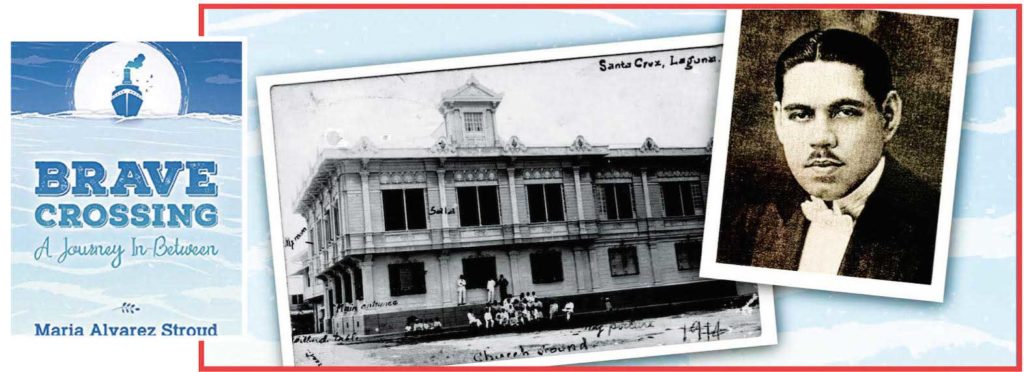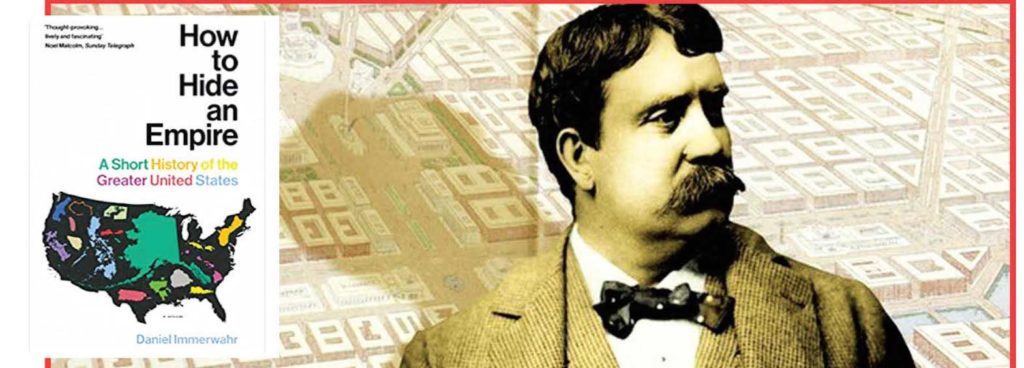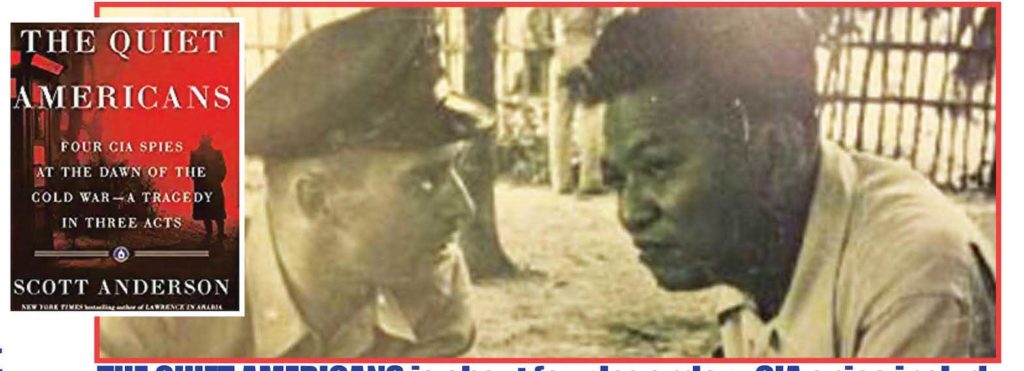Three good reads for Filipino American History Month

BRAVE CROSSING: Ricardo Alvarez left Laguna in 1917 with a dream of studying Medicine in Chicago only to encounter racism and isolation in between World War I, Spanish Flu Pandemic and the Ku Klux Klan.
Getting hold of Maria Alvarez-Stroud’s book, Brave Crossing—A Journey in Between, I quickly gleaned over the pages. I initially got the impression that I had another collection of letters. I am still struggling to finish reading the three-volume collection of Jose Rizal’s letters, so I almost set aside Stroud’s opus until I realized it was a historical novel in an epistolary style.
Stroud discloses that her father, Ricard Alvarez, is the only real person in her story and all others are composites of the people that her dad had encountered since he left his hometown of Sta. Cruz, Laguna in 1919, leaving a privileged life of a Filipino-Spanish mestizo, and crossing the Pacific on an ocean liner, with a dream of entering medical school in the U.S.
Soon enough, Ricardo who ranked notches higher in the totem pole of Philippine society, found that his skin was not white enough to readily get accepted, despite being as privileged as he was back home. Thus, his journey into losing his “innocence” began.
It did not take long for me to realize that Ricardo’s experience was that of my own father who quit high school in Pampanga and found himself working in various speakeasies in Chicago in the early 1920s. As a conductor on a train that plied between Chicago and Florida, he was stricken with a pulmonary ailment that forced him to go back home after five years in the Windy City.
My father took pride in his stay in the U.S., basking in the reputation that he was the only resident of Barrio Candating in Arayat, Pampanga who made it to the States up to the early 1950s. He often held court, sharing his stories about his Stateside life.
I heard him talk about gangsters, taxi dancers and getting in a brawl. Curiously, I never heard him complain about racism, discrimination and alienation that Ricardo had experienced. Ricardo’s story resonated with me—filling the gaps in my father’s narratives.
Credit Stroud’s inventiveness and imaginative portrayal of the times that her father had lived in; she weaves epic events like the Great World War, the 1918 Spanish Flu pandemic, the Chicago Race Riot and the resurgence of the Ku Klux Klan. Sounds like today’s headlines? Stroud’s novel is an important addition to the Filipino American Experience. I venture to say, Brave Crossing should be on a recommended list of books for students, much like Sandra Cisneros’ The House on Mango Street. Yes, in many ways, Ricardo’s is our story.

HOW TO HIDE AN EMPIRE that includes the Philippines. The exclusionary U.S. policies in its colonies made that “Bulwark of Democracy” come out short of its exemplary image. Daniel Burnham planned Manila and Baguio: Off limits to Filipinos
How to Hide an Empire—A History of the Greater America is proof that history is fun to read. Daniel Immerwahr’s book is filled with amusing episodes involving memorable characters. But it’s more than trivia. It’s so interesting and leaves you thinking about a nation that claims to be a bulwark of democracy yet comes up short when hidden events are exposed.
The book chronicles the nation’s relentless quest to expand, over Native American’s land, then on across the Caribbean and the Pacific — Cuba, Puerto Rico, the Philippines. Yet, for all the natural resources and strategic locations that the U.S. acquired, it consciously marginalized the inhabitants of the land it had taken over.
By and large, U.S. policies were paternalistic, exclusionary and misogynistic. This book’s coverage is expansive. The Philippines is but a segment, taken over from Spain and from Filipino revolutionaries, leading to the Philippine American War of 1899-1903, which was effectively swept under the rug in U.S. historical accounts.
Casualties were high—an estimated 5,000 on the U.S. side who died mostly from tropical diseases. No fewer than 600,000 Filipinos died from lopsided military encounters–mostly civilians who suffered from mass killings, hunger and displacements.
During the 48 years of actual U.S. presence in the archipelago, a liberal democratic government, public schools and a health system were introduced, along with military bases and onerous economic agreements.
Chicago architect and planner Daniel Burnham was deployed to do the 1905 Plan of Manila and the design of Baguio as a Summer Capital for the exclusive use of American administrators. (No Filipinos allowed.) This was typical of a bipolar treatment of the natives.
Filipinos, like the Pacific Islanders, did not have a right to vote or representation in the U.S. Congress. These inhabitants had limited access to the mainland. Americans in the contiguous 48 states at that time hardly knew of the existence of the peoples in the colonies.
When World War II broke out, the Philippines was abandoned in favor of the war in Europe. FDR’s promise of the U.S. would defend the Philippines came up empty— both U.S commander in the Far East, Gen. Douglas MacArthur and Commonwealth President Manuel Quezon were holed up on Corregidor in 1942 waiting in vain for the U.S. military convoys that never came.
These and more are all in Immerwahr’s readable book, a valuable resource for understanding the U.S. role in the world today. Reading of these events that were sadly glossed over for so long a time can elicit feelings of angst and anger.

THE QUIET AMERICANS is about four legendary CIA spies, including creator of the Ramon Magsaysay Presidency, Edward Lansdale, whose covert work came out short in Indo-China.
The Quiet Americans—Four CIA Spies at the Dawn of the Cold War—a Tragedy in Three Acts
It feels ominous that I checked out from the Skokie Library Anderson’s book while the U.S. was in a chaotic exit from Afghanistan this summer–A tragedy as America’s “Longest War” with 5,000 US troops dead and $3 trillion down the drain. Anderson should update his book and call it “A Tragedy in FOUR Acts.”
Four legendary CIA spies including Edward Lansdale are the main actors in this tragic account of historian Scott Anderson, who wrote the New York best-seller, “Lawrence of Arabia.” (The book’s title is a take-off from Graham Greene’s The Quiet American, a classic novel based on Lansdale ‘s exploit in Vietnam.)
His new book is a post WWII account of the U.S. struggle to rein in Communism. The Cold War waged against the Russians involved covert and overt activities of the Central Intelligence Agency (CIA) and its Soviet counterpart, the KGB.
Reading it relives fateful events, like the building of the Berlin Wall, the apocalyptic Cuban Missile Crisis, assassinations and attempted assassination xof national leaders, the Iran and other Middle East crises, the Red Army’s victory in 1949, the McCarthy Witch Hunt of the 1950s—well, you get the idea.
The CIA activities cover a vast expanse of U.S contemporary history. Let’s focus on the CIA and the Philippines. The U.S. granted independence on July 4, 1946 while the country was down on its knees after the massive devastation from WWII—thanks to massive bombing from the US liberation armed forces.
In late 1940s, a peasant revolt was gaining ground in Luzon. The Manila government was saddled with corruption. Enter CIA operative, Edward Lansdale, the man who groomed President Elpidio Quirino’s Defense Secretary, Ramon Magsaysay, as the man to defeat Quirino in the 1952 presidential elections.
It is now common knowledge that Lansdale’s American logistics and tactics paved Magsaysay’s way to the Presidential Palace. Lansdale literally took residence in Malacanang and his office was right next to the president. Soon, the peasant uprising fizzled out and Lansdale was not shy about taking credit for that.
Washington leaned on his “success” in the Philippines and sent Lansdale to Vietnam. Thus began the tragic involvement of the U.S in Indo-China. The war to win the “Hearts & Minds” of the Vietnamese evolved into a bloody and expensive conflict that divided even the American people.
The lessons of the Fil-Am War at the Turn of the Century, which historians called “The First Vietnam,” was not learned for the simple reason that its history was purged from U.S. History books. The tragedy repeated itself. Not only in Vietnam. But also in Iraq. Now in Afghanistan. “When will we ever learn…”
Brave Crossing: the Journey In-Between, by Maria Alvarez Stroud, Historical Fiction,
How to Hide an Empire: A History of the Greater United States by Daniel Immerwahr, Picador, 528 pp. $20 Publisher: Little Creek Press.
The Quiet Americans–Four CIA Spies at the Dawn of the Cold War–A Tragedy in Three Acts by Scott Anderson, Doubleday, 562 pp, $9.99 ebook, $18.95 print.

